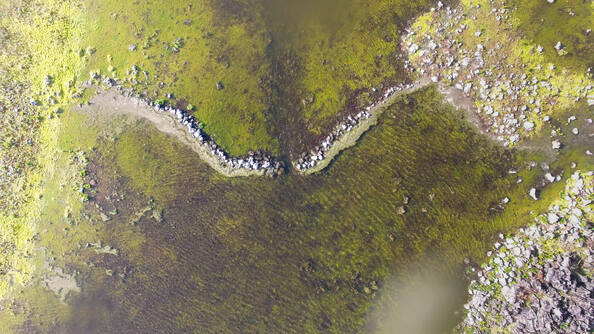Культурный ландшафт Будж Бим
Budj Bim Cultural Landscape
The Budj Bim Cultural Landscape, located in the traditional Country of the Gunditjmara people in south-eastern Australia, consists of three serial components containing one of the world’s most extensive and oldest aquaculture systems. The Budj Bim lava flows provide the basis for the complex system of channels, weirs and dams developed by the Gunditjmara in order to trap, store and harvest kooyang (short-finned eel – Anguilla australis). The highly productive aquaculture system provided an economic and social base for Gunditjmara society for six millennia. The Budj Bim Cultural Landscape is the result of a creational process narrated by the Gunditjmara as a deep time story, referring to the idea that they have always lived there. From an archaeological perspective, deep time represents a period of at least 32,000 years. The ongoing dynamic relationship of Gunditjmara and their land is nowadays carried by knowledge systems retained through oral transmission and continuity of cultural practice.
La description est disponible sous licence CC-BY-SA IGO 3.0
Paysage culturel Budj Bim
Le paysage culturel Budj Bim situé dans le pays traditionnel du peuple Gunditjmara dans le sud-est de l’Australie se compose de trois éléments constitutifs, qui forment l’un des plus vastes et des plus anciens systèmes aquacoles au monde. Les coulées de lave du Budj Bim servent de base à un système complexe de canaux, de barrages et de digues mis au point par les Gunditjmara pour capturer, stocker et récolter le kooyang (anguille à ailerons courts – Anguilla australis). Ce système d’aquaculture extrêmement productif a servi de base économique et sociale à la société Gunditjmara pendant six millénaires. Le paysage culturel Budj Bim résulte d’un processus de création que relatent les Gunditjmara comme une histoire de temps profond, qui renvoie à l’idée qu’ils ont toujours vécu là. D’un point de vue archéologique, le temps profond désigne une période d’au moins 32 000 ans. La relation dynamique que les Gunditjmara continuent d’entretenir avec leur territoire est soutenue aujourd’hui par des systèmes de connaissances, conservés grâce à la transmission orale et à la pérennité des pratiques culturelles.La description est disponible sous licence CC-BY-SA IGO 3.0
لمنظر الثقافي في بودج بيم
يشمل المشهد الثقافي، الواقع في منطقة شعوب الغونديجمارا الأصليين جنوب غرب البلاد، بركان بودج بيم وبحيرة تاي راك (كونداه)، إلى جانب منطقة كورتونيتج التي تتميّز بأراضيها الرطبة، ومنطقة تيريندارا في الجنوب، والتي تتميز بعدد من التلال الصخرية والمستنقعات الكبيرة. وقد مكّنت تدفقات الحمم البركانية في بركان بودج بيم، التي تربط بين هذه العناصر الثلاثة، شعوب الغونديجمارا من إنشاء واحدة من أكبر وأقدم شبكات تربية الأحياء المائية في العالم. وتساعد بفضل القنوات والسدود والحواجز المائية، على احتواء مياه الفيضانات، وإنشاء أحواض لاصطياد حيوانات الأنقليس الجنوبي وتخزينها وجمعها، وقد شكل هذا النشاط للسكان قاعدة اقتصادية واجتماعية لستة آلاف عام.
source: UNESCO/CPE
La description est disponible sous licence CC-BY-SA IGO 3.0
布吉必姆文化景观
该遗产地位于澳大利亚西南部土著民族贡第杰马若人的生活区,包括布吉必姆火山、康达湖、湿地及沼泽地众多的Kurtonitj地区和南部由石灰岩山脊和大型湿地组成的Tyrendarra地区。连接以上3地的由布吉必姆岩浆流形成的水系让贡第杰马若人建成了世界上最大、最古老的水产养殖网络之一。各水道、水坝和堤坝可用于容纳洪水、建立蓄水池和捕捉及饲养澳洲鳗鲡,这种鱼类的养殖是当地人民6千年来重要的经济和社会生活的基础。
source: UNESCO/CPE
La description est disponible sous licence CC-BY-SA IGO 3.0
Культурный ландшафт Будж Бим
Культурный ландшафт Будж Бим расположен в регионе коренного народа Гундитжмара на юго-востоке страны. Этот объект включает вулкан Будж Бим, Тэ-Рак (Озеро Конда), водно-болотные угодья Куртонитжа и Тайрендарру – область на юге со скалистыми хребтами и обширными болотами. Потоки лавы Будж Бим, соединяющие эти три элемента, позволили народу Гундитжмара создать одну из крупнейших и старейших в мире сетей аквакультуры. Эта сложная система, состоящая из каналов, плотин и дамб, используется для сдерживания паводковых вод и создания рыбохозяйственного бассейна с целью отлова и разведения австралийского речного угря (Anguilla australis), который служил ключевым элементом социально-экономического развития региона в течение шести тысячелетий.
source: UNESCO/CPE
La description est disponible sous licence CC-BY-SA IGO 3.0
Paisaje cultural de Budj Bim
Situado al sudoeste del país, en la región de la nación gunditjmara, este sitio comprende tres elementos: el volcán Budj Bim; el Tae Rak (lago Condah), con las ciénagas de zonas húmedas de Kurtonitj; y el paisaje de crestas rocosas y grandes pantanos de Tyrendarra, en la parte meridional. Aprovechando las corrientes de lava del Budj Bim que unen esos tres elementos, el pueblo gunditjmara creó uno de los sistemas de acuicultura más vastos y antiguos del mundo. Integrado por una red de canales, diques y presas que retienen las aguas de las crecidas y forman embalses, ese sistema permite atrapar, almacenar y recoger la anguila “kuyang” (Anguilla australis). Durante seis milenios esta actividad piscícola ha constituido uno de los pilares socioeconómicos de esta nación aborigen.
source: UNESCO/CPE
La description est disponible sous licence CC-BY-SA IGO 3.0
